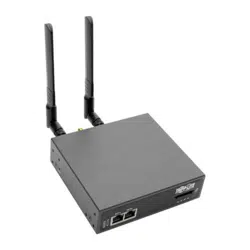Loading ...
Loading ...
Loading ...

225
14. Configuration from the Command Line
Below are the specific settings, depending on the type of alert required:
Connection Alert
To trigger an alert when a user connects to serial port 5 or network host 3:
# config -s config.alerts.alert2.host3=’host name’
# config -s config.alerts.alert2.port5=on
# config -s config.alerts.alert2.sensor=temp
# config -s config.alerts.alert2.signal=DSR
# config -s config.alerts.alert2.type=login
Signal Alert
To trigger an alert when a signal changes state on port 1:
# config -s config.alerts.alert2.port1=on
# config -s config.alerts.alert2.sensor=temp
# config -s config.alerts.alert2.signal=[ DSR | DCD | CTS ]
# config -s config.alerts.alert2.type=signal
Pattern Match Alert
To trigger an alert if the regular expression ‘.*0.0% id’ is found in serial port 10’s character stream:
# config -s “config.alerts.alert2.pattern=.*0.0% id”
# config -s config.alerts.alert2.port10=on
# config -s config.alerts.alert2.sensor=temp
# config -s config.alerts.alert2.signal=DSR
# config -s config.alerts.alert2.type=pattern
UPS Power Status Alert
To trigger an alert when myUPS (on localhost) or thatUPS (on remote host 192.168.0.50) power status changes between
on-line, on-battery and low battery:
# config -s config.alerts.alert2.sensor=temp
# config -s config.alerts.alert2.signal=DSR
# config -s config.alerts.alert2.type=ups
# config -s config.alerts.alert2.ups1=myUPS@localhost
# config -s confi[email protected]
Environmental and Power Sensor Alert
# config -s config.alerts.alert2.enviro.high.critical=’critical value’
# config -s config.alerts.alert2.enviro.high.warning=’warning value’
# config -s config.alerts.alert2.enviro.hysteresis=’value’
# config -s config.alerts.alert2.enviro.low.critical=’critical value’
# config -s config.alerts.alert2.enviro.low.warning=’warning value’
# config -s config.alerts.alert2.enviro1=’Enviro sensor name’
# config -s config.alerts.alert2.outlet#=’RPCname’.outlet#
‘alert2.outlet#’ increments sequentially with each added outlet. The second ‘outlet#’ refers to the specific RPC power outlets.
# config -s config.alerts.alert2.rpc#=’RPC name’
# config -s config.alerts.alert2.sensor=[ temp | humid | load | charge]
# config -s config.alerts.alert2.signal=DSR
# config -s config.alerts.alert2.type=enviro
# config -s config.alerts.alert2.ups1=’UPSname@hostname’
Example 1: To configure a temperature sensor alert for a sensor called ‘SensorInRoom42’:
# config -s config.alerts.alert2.sensor=temp
# config -s config.alerts.alert2.enviro.high.critical=60
# config -s config.alerts.alert2.enviro.high.warning=50
# config -s config.alerts.alert2.enviro.hysteresis=2
# config -s config.alerts.alert2.enviro.low.critical=5
# config -s config.alerts.alert2.enviro.low.warning=10
# config -s config.alerts.alert2.enviro1=SensorInRoom42
# config -s config.alerts.alert2.signal=DSR
# config -s config.alerts.alert2.type=enviro
Loading ...
Loading ...
Loading ...
